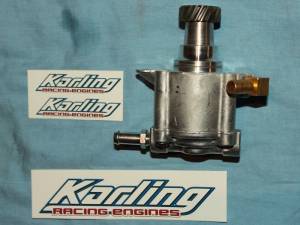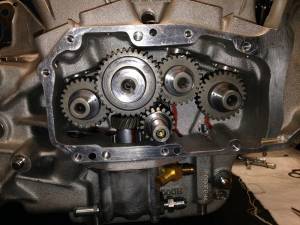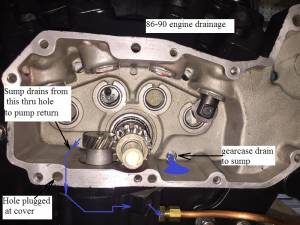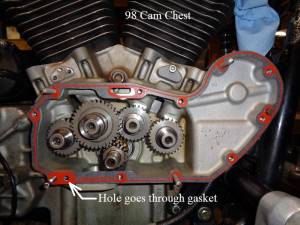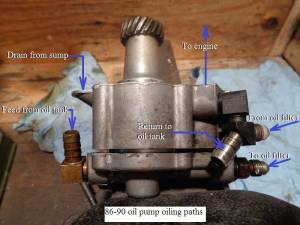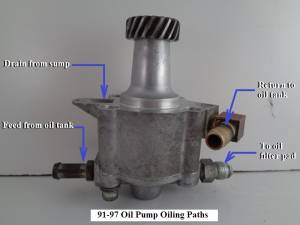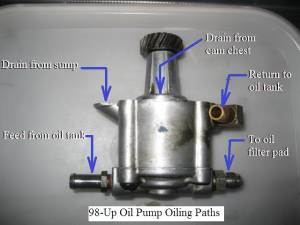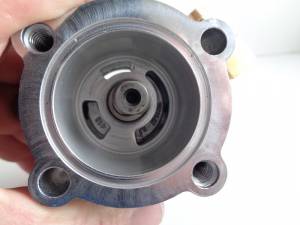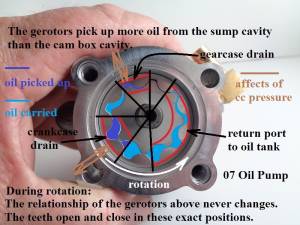Table of Contents
REF: Oiling & Lubrication - Sub-05F
Modding a 98-up style Oil Pump For Use in 86-90 Engines
Related articles in the Evo section of the Sportsterpedia:
…….. * Engine Oil System
…….. * Engine Oil Routes
Karling Racing in Sweden designed this mod after flow testing a 2007-up Sportster oil pump for use in an 86-90 engine. 1) 2)
Contact:
Karling Racing.com
Telephone +46(8)51400488
E-mail: sale@karlingracing.com
Applications for this mod
This oil pump modification is only suitable in engines where you want to maximize crankcase sump scavenging.
It was originally designed with a 124“ S&S motor in mind. The Xlforum build thread is here.
A Karling modified 2007-and-up oil pump may be an improvement in Sportster Evo engines with pre-98 H-D OEM cases.
These engines were not made to scavenge from the cam chest either. They have the oil drain from the cam chest to the sump.
So with a Karling-modified oil pump these engines will receive the full scavenge capacity of the 2007-and-up pumps.
Originally designed for 86-90 engines.
Suitable for 91-96 engines.
Not recommeneded for 98 and up engines.
It's not a solution or even a consideration for 98-up Sportster engines.
(or rather any that require an oil pump scavenge port in the cam chest)
Background
Previously, most engine builders fitted 4-cam race engines with ProFlow 3-stage or 4-stage oil pumps.
Since those pumps are now discontinued, engine builders (Karling and others) often use these OEM pumps for;
S&S SA XL and S&S Pro Stock XL-cased race engine builds as well as Delcron and McClure cased 4-cam race engines.
In 1998 H-D improved the scavenge capacity of the oil pump and introduced a suction port to the cam chest in the oil pumps.
At the same time they also excluded the oil drain hole from the cam chest to the sump.
So from then on, the oil pump cam chest suction port is solely responsible for cam chest scavenging.
Therefore, the oil pumps cam chest suction port will receive all of the oil entering the cam chest.
This was possibly done in order to solve the issues with (too much) oil in the crankcase, or more affectionally known as "Wet Sumping".
This would reduce the amount of oil entering the crankcase.
In 2004, H-D seemed to have moved further on with the same idea.
They re-routed the cylinder head oil returns from the crankcase to the cam chest.
However, the rubbermount was also fitted with piston jets.
This addition did not add any extra oil to the crankcase but rather kept some oil circulating in the crankcase.
(by kidnapping a portion of splash oil that would normally be sent to the gearcase)
The splash ports are still operational but the ports were restricted to repurpose some of the oil collected there.
In 2007, more improvements were made to the oiling system including bigger feed and return gerotors.
(increased the oil flow capacity even further)
Cam chest drainage
Notice the differences in the 86-90 and 91-up cam chest floor.
The elevation is stepped down from left to right on both cases.
The left side of the cam chest on both style cases will be splashed by the cam gears, pinion and oil pump gears, crankcase windage and etc.
Both also have a sunken elevation between the cover mounting bolts on each side of the oil pump.
This will allow oil to settle there and drain into the pump's top port (assuming both would have the newer oil pump mounted).
However, 86-90 cases also have a cupped dip between the oil pump and the pinion gear lowering the elevation away from the pump.
The 91-up cases have a slightly lower elevation between the bolts running flat in that area.
This creates slightly more area for oil to gather and allow it to settle there.
Normally in 86-97 engines, the oil just gathers there and eventually splashes elsewhere.
In 98-up engines, the oil gathered in this area drops down to the oil pump with the extra drain port.
And of course, when the oil level rises above the cover mounting bolt under the pinion gear on both cases, oil spills to the right (lower side) of the cam chest floor.
86-97 engines would drain that part of the cam floor to the crankcase sump.
98-up engines just let it sit there and eventually splash elsewhere also.
There are no provisions in the cam covers to transport the oil on the cam floor anywhere else.
Click here to see Evo cam chests from different year models in the Sportsterpedia.
Sportster oil pumps
The design of the oil pumps changed with the different oiling system changes to the engines.
You can see the runners on the top of the 98-up pumps leading to the cam chest drain port.
Reason this mod came to be
During the 124” build, a 2007-up Sportster oil pump was installed.
Upon dyno testing, it was revealed that there was a reduction in max power and torque pointing wetsumping at high RPM.
Tests were also done running the bike at different rpms, then stopping the engine to drain and measure the volume of oil in the sump.
These test also pointed to at wetsumping.
Then, suspected culprit was the oil pump. The modern (1998-up) H-D oil pumps have a suction port in the cam chest.
But unlike modern H-D cases, the S&S cases drain the cam chest to the crankcase sump.
And that drain hole is situated at a lower point in the cam chest than the cam chest suction port to the oil pump.
Then it was thought that the camchest suction port in the oil pump only delivers air into the oil return gerotor in this application.
(thereby lowering the possible return flowrate from the sump)
So the idea came about to close off the front drain port in the 2007 oil pump.
Testing
1986-1997 engines drain the gearcase into the crankcase sump area to be scavenged by the sump drain to the oil pump.
1998-up engines drain the gearcase straight into the oil pump.
However, the 07 pump is preferred as it has bigger scavenge gerotors that carry more oil out of the engine than it's predecessor.
So testing was done on the 2007 pump to determine flow rate.
The pump was tested before and after the modification in Karlings oil pump test rig.
During the flow test, they used a reference volume filled from the scavenge outlet.
The pump was driven at a controlled shaft speed and partially immersed in a low viscosity fluid to resemble the viscosity of hot engine oil.
When the cam chest suction port was allowed to suck air, (sump suction port immersed in liquid), the pump needed 22 seconds to fill the reference volume.
With this mod, (also the internal gerotor kidney was machined to optimize sump port scavenge capacity), pump only needed 13.5 seconds to fill the reference volume.
The testing determined that the 2007 oil pump gained 63% scavenge capacity when the oil pumps cam chest scavenge port was modified (blocked off).
Then the plausible consequence (without modding) was that the engine wetsumps the crankcase to a level that is sufficient to flood the lower part of the cam chest.
Not until then will the full oil pump scavenge capacity be used.
Considerations
This mod may improve scavenging of the crankcase sump but it is not the end of wet sumping in the engine.
1986-1991 engines have an oil pressure regulator that dumps excess oil pressure from the filter pad directly into the gearcase.
When the regulator malfunctions, additional oil is dumped into the gearcase more often and at varying riding conditions.
Read more about Oil Pressure Regulator Mods in the REF section of the Sportsterpedia.
Purpose of this mod
Several mods have been devised in an attempt to scavenge more oil from 86-90 engines.
One of which is the 5 Speed Oil Pump on 4 Speed Models (Conversion for 86-90 Evo engines)
(adapting the engine case to accept a newer style oil pump to an 1986-1990 engine for better oil control)
This mod addresses the issue of the cam chest drain port in the newer style pumps that is not required in 1986-1996 engines.
When using 1998-up oil pumps for earlier engines:
The concern is since the early engine drains the gearcase into the sump and the 2007 pump has an open port in the cam chest;
You may be adding more air/aeration into the return system through the gearcase port in the pump.
(which may lead to an increased risk of cavitation) 11)
98-up oil pump gearcase drain ports:
In the pic below, the rotation of the gerotors is counter-clockwise.
The sump cavity is on the left, middle is the cam chest drain port and on the right is the return cavity to the oil tank.
The pickup from the sump is directly sent to the return cavity while the cam chest port fills after the return cavity empties.
Air will compress but oil will not.
Likewise, air that is displaced into the cam port will either be sent out or compressed by the oil as the gerotors turn into the sump port.
See also the Evo Oil Pump Section of the Sportsterpedia.
Results
When the gearcase port was allowed to suck air with the sump port immersed in liquid, the pump needed 22 seconds to fill the reference volume. 14)
With the cam chest port blocked off and the internal gerotor kidney machined to optimize sump port scavenge capacity;
The pump only needed 13.5 seconds to fill the reference volume.
If the cam suction port is fed with air, the total scavenge flow of the 2007-up XL-pump drops to 61%.
Conclusions from testing
The results reportedly revealed that this modification increases the return flow from the sump by 63%.
This shows how much return capacity that is left on the table using the 2007 pump (if there's no oil in the cam chest to fall into the top port).
However, the testing was done in a controlled environment.
It is also assuming that the cam chest port in the pump is either full of oil or full of air during normal installed operation.
This will never be true in the real world.
In a 1986-1990 engine;
Crankcase pressure, cam and pinion gears will end up dropping oil mist and splash oil into the cam chest port of the 1998-up oil pumps.
It may not be a steady supply of oil but the cam chest port would never be completely dry.
The pressure regulator in the 1986-1991 engines will dump excess oil into the gearcase as it was designed to do.
Some of this will also splash / get splash into the cam chest drain port.
The regulator is notorious for leaking oil into the gearcase as well (when not activated by designed means).
So the results, even though interesting, will vary constantly inside a running 1986-1990 engine.
However, the Karling mod will eliminate the chance of cavitation in the oil pump (that's due from induced air into the cam chest port of the newer style oil pumps)


